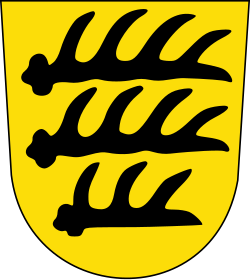Württembersko
| Württembersko Württemberg | |
|---|---|
| Geografie | |
| Hlavní město | Stuttgart (historické) |
| Status | historická země |
| Souřadnice | 48°46′43″ s. š., 9°10′46″ v. d. |
| Obyvatelstvo | |
| Jazyk | švábská němčina |
| Náboženství | luteránství, římskokatolictví |
| Správa regionu | |
| Stát | |
| Nadřazený celek | |
| Některá data mohou pocházet z datové položky. | |
Württembersko (německy Württemberg) je historická země a někdejší stát v letech 1083–1918 v jihozápadním Německu na místě současné spolkové země Bádensko-Württembersko. Hlavním městem Württemberska byl Stuttgart. Po určitou dobu jeho vládcové sídlili také ve městech Ludwigsburg a Urach. Od středověku bylo součástí německého státu, Svatou říší římskou počínaje, v průběhu času bylo hrabstvím, vévodstvím, kurfiřtstvím, královstvím a nakonec republikou.
Historické etapy
 hrabství (1083–1495)
hrabství (1083–1495) vévodství (1495–1803)
vévodství (1495–1803) kurfiřtství (1803–1806)
kurfiřtství (1803–1806) království (1806–1918)
království (1806–1918) svobodný lidový stát (1918–1945)
svobodný lidový stát (1918–1945)
Historie
Württembersko vzniklo jako hrabství v průběhu 11. století odtržením se od Švábského vévodství. Roku 1495 se pod vládou Eberharda I. stalo vévodstvím. Po pádu Svaté říše římské roku 1806 z něj panovník Friedrich I. učinil království. Tento stav vydržel až do roku 1918, kdy na jeho území vznikla republika. Po druhé světové válce bylo rozděleno mezi americkou a francouzskou okupační zónu a vznikly tak dvě nové země: Württembersko-Bádensko a Württembersko-Hohenzollernsko. Tyto země se roku 1949 staly spolkovými zeměmi nově vzniklé Spolkové republiky Německo a byly roku 1952 spojeny s Jižním Bádenskem. Tak vznikla současná spolková země Bádensko-Württembersko.
Německý název země je odvozen od hory Württemberg ve Stuttgartu, v městské čtvrti Untertürkheim.
Symbolika
- vlajka:
- hrabství, vévodství
- království a republika
- znak:
- svobodný lidový stát
Reference
V tomto článku byly použity překlady textů z článků Württemberg na německé Wikipedii a Württemberg na anglické Wikipedii.
Externí odkazy
 Obrázky, zvuky či videa k tématu Württembersko na Wikimedia Commons
Obrázky, zvuky či videa k tématu Württembersko na Wikimedia Commons - Malý lexikon historie Bádenska a Württemberska
Média použitá na této stránce
Flag of the Kingdom of Württemberg; Ratio (3:5)
Autor: Samhanin, Licence: CC BY-SA 3.0
Coat of arms of the Electorate of Württemberg (1803-1806) 1.duchy of Teck; 2: principality of Ellwangen; 3: county of Mömpelgard; 4: lordship of Justingen; 5: county of Limpurg (Schenken von Limpurg) (The Limpurg Hills (German: Limpurger Berge) are a hill range, up to 564.7 m above sea level (NHN),[1] in the Swabian-Franconian Forest in the counties of Schwäbisch Hall and Ostalbkreis in the German state of Baden-Württemberg. The majority of the region belonged formerly to Limpurg Land owned by the family of Schenken von Limpurg, whose name was derived from their family home, Limpurg Castle near Schwäbisch Hall.); 6: lordship of Heidenheim; 7: lordship of Bönnigheim; 8a: Altdorf?; 8b: Esslingen or Heilbronn? 8c; Mindelheim? heart a: duchy of Württemberg; heartb: Reichssturmfahne. Inescutcheon is backwards and thus ahistorical.
Autor: Glasshouse, Licence: CC BY-SA 3.0
The coat of arms of the Kingdom of Württemberg adopted by King Wilhelm I on December 30, 1817.
Autor: MostEpic, Licence: CC BY-SA 4.0
Coat of Arms of the Dukes of Württemberg. In 1693 the arms were further expanded after the acquisition of the lordship of Heidenheim, incorporating the heathen's head as an additional quartering: Or, a heathen's head bearded proper dressed and capped gules with collar and flap azure and buttons or. Canting arms, German Heidenheim means "the heathen's home".([1])
Flag of Württemberg from before 1809.
Banner of the Arms of the Duchy of Württemberg.
Arms of the Free State of Württemberg





















